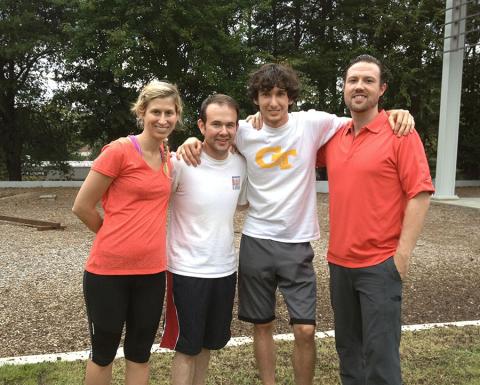The two-year TI:GER program’s interdisciplinary approach intersects science, law, and business and brings together Georgia Tech Ph.D. and M.B.A. students with law students from Emory University. The program is nationally recognized for its success at developing entrepreneurs.
Doctoral students in the School of Electrical and Computer Engineering (ECE) are accustomed to conducting world-class research that leads to innovative technologies, but when it comes to translating a great idea into a marketable product there can often be a disconnect. How does a technology researcher learn about topics such as patent law, business plans, marketing strategy, and intellectual property analysis? The TI:GER (Technological Innovation: Generating Economic Results) program in the Scheller College of Business can bridge the gap.
The two-year program’s interdisciplinary approach intersects science, law, and business and brings together Georgia Tech Ph.D. and M.B.A. students with law students from Emory University. The program is nationally recognized for its success at developing entrepreneurs. Teams are formed in the first semester and consist of one Ph.D., two MBA, and two law students. Up to seven new research students are accepted each year and the teams form around their doctoral projects. Sometimes the research is successfully commercialized; sometimes it is not.
ECE Ph.D. students Matthieu Leibovici and Amir Dindar, advised by Professor Tom Gaylord and Professor Bernard Kippelen, respectively, are currently enrolled in the TI:GER program. While they are at different stages in the program, both are reaping the rewards of TI:GER’s four-course academic track that provides instruction in technology commercialization processes with a focus on technology law and business fundamentals. An added benefit of the program is that many of the research students receive a two-year, half-time graduate research assistantship to cover their stipend and tuition waiver.
Matthieu Leibovici and his team are in the first semester of the program and are pursing the commercialization of pattern-integrated interference lithography (PIIL) technology, the subject of his graduate research currently developed in the GT Optics Laboratory. The lack of rapid and inexpensive fabrication techniques for periodic structures at the nano-scale has resulted in a significant roadblock to commercial development. PIIL addresses the limitations of multi-beam interference lithography by coupling it with projection lithography simultaneously. PIIL has far-reaching possibilities in areas such as optical communications, HD displays, solar cells, and biomedical devices, among others.
While Leibovici and his team hope to commercialize the technology and are currently seeking partners for development and licensing, he is quick to stress that TI:GER is not an incubator, but an education program. He says, “The goal is for Ph.D. students to gain business and legal skills in an environment of learning how to commercialize a technology, but you don’t ‘fail’ if you don’t launch a company.”
Second year TI:GER participant, Amir Dindar, is researching an ink-jet printed organic thin-film solar cell module for his electrical engineering doctoral degree. With this emerging technology, a solar cell module can be fabricated on top of glass as well as flexible substrates such as plastic. Low fabrication costs combined with applications that include futuristic new products such as bendable and disposable electronics had Dindar’s TI:GER team excited about taking the product to market.
The one downside of organic solar cells is low-efficiency compared to conventional cells. The team knew this was a hurdle, but as part of their coursework, they embarked on an extensive discovery phase that involved in-depth industry analysis, product concepting, and market segmentation. In the end, their research uncovered that the return on investment was too low to make the technology viable in the market—for now.
“We learned a valuable lesson through our analysis. In academia, you aren’t as concerned about the market, but in industry it often happens that your idea isn’t feasible. You have to either stop the project or change direction. TI:GER helped me pinpoint problems in my research and now I have the opportunity to solve them,” says Dindar.
The program, which was started in 2002 with funds from the National Science Foundation, provides a unique opportunity to ECE doctoral students. Adding an advantageous dimension to ECE curriculum, TI:GER teaches students to be both innovators and entrepreneurs. This duality is what academic institutions and industry are looking for in new hires.
Marie Thursby, Director of the TI:GER program says, “Programs like TI:GER give engineering students a competitive edge in the market. It’s not enough to just have the technical knowledge. Companies are looking for students with leadership skills and an understanding of what it takes to capitalize on technology.”
Interested students can plan to attend the information session on February 18, 2014. Please RSVP to Jennifer Jacobs by Feb. 17th. For more information, click here.
